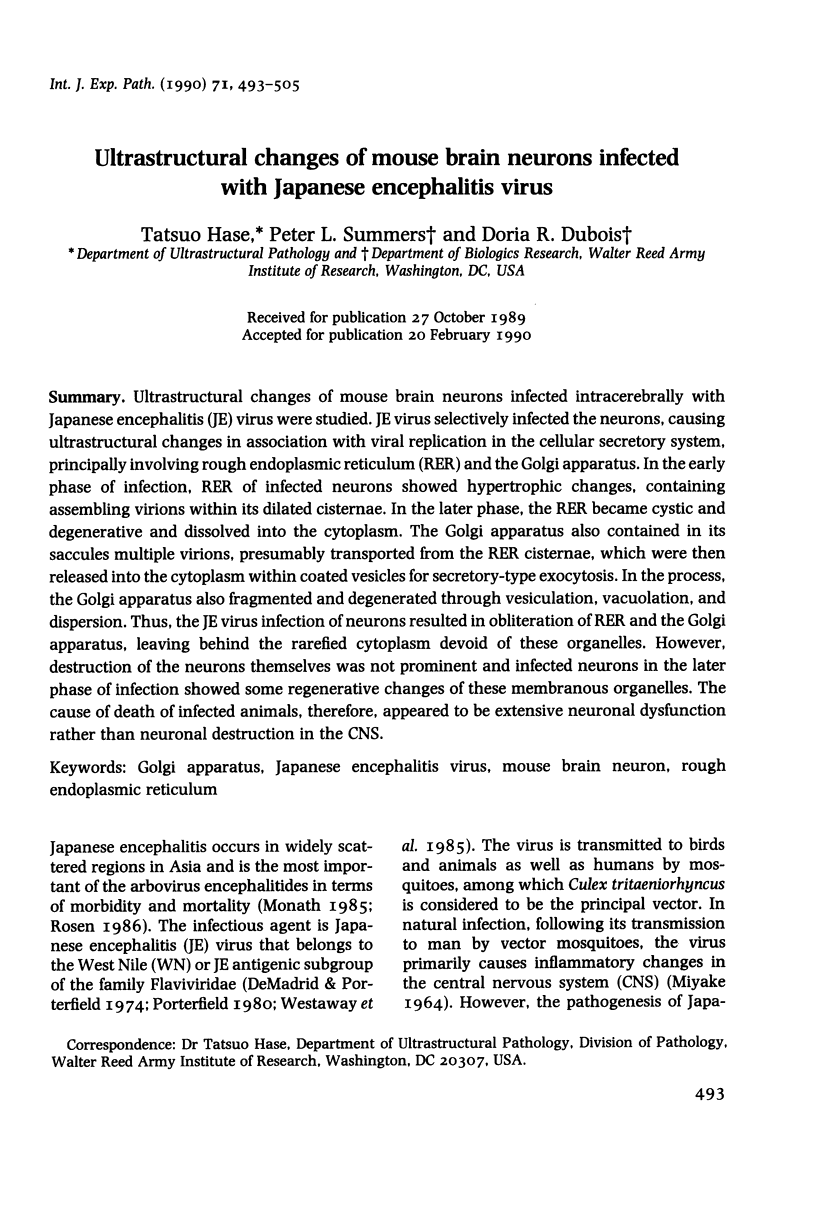Ultrastructural changes of mouse brain neurons infected with Japanese encephalitis virus (original) (raw)
. 1990 Aug;71(4):493–505.
Abstract
Ultrastructural changes of mouse brain neurons infected intracerebrally with Japanese encephalitis (JE) virus were studied. JE virus selectively infected the neurons, causing ultrastructural changes in association with viral replication in the cellular secretory system, principally involving rough endoplasmic reticulum (RER) and the Golgi apparatus. In the early phase of infection, RER of infected neurons showed hypertrophic changes, containing assembling virions within its dilated cisternae. In the later phase, the RER became cystic and degenerative and dissolved into the cytoplasm. The Golgi apparatus also contained in its saccules multiple virions, presumably transported from the RER cisternae, which were then released into the cytoplasm within coated vesicles for secretory-type exocytosis. In the process, the Golgi apparatus also fragmented and degenerated through vesiculation, vacuolation, and dispersion. Thus, the JE virus infection of neurons resulted in obliteration of RER and the Golgi apparatus, leaving behind the rarefied cytoplasm devoid of these organelles. However, destruction of the neurons themselves was not prominent and infected neurons in the later phase of infection showed some regenerative changes of these membranous organelles. The cause of death of infected animals, therefore, appeared to be extensive neuronal dysfunction rather than neuronal destruction in the CNS.

Images in this article
Selected References
These references are in PubMed. This may not be the complete list of references from this article.
- De Madrid A. T., Porterfield J. S. The flaviviruses (group B arboviruses): a cross-neutralization study. J Gen Virol. 1974 Apr;23(1):91–96. doi: 10.1099/0022-1317-23-1-91. [DOI] [PubMed] [Google Scholar]
- Hase T., Summers P. L., Eckels K. H. Flavivirus entry into cultured mosquito cells and human peripheral blood monocytes. Arch Virol. 1989;104(1-2):129–143. doi: 10.1007/BF01313814. [DOI] [PubMed] [Google Scholar]
- McDowell E. M., Trump B. F. Histologic fixatives suitable for diagnostic light and electron microscopy. Arch Pathol Lab Med. 1976 Aug;100(8):405–414. [PubMed] [Google Scholar]
- Murphy F. A., Harrison A. K., Gary G. W., Jr, Whitfield S. G., Forrester F. T. St. Louis encephalitis virus infection in mice. Electron microscopic studies of central nervous system. Lab Invest. 1968 Dec;19(6):652–662. [PubMed] [Google Scholar]
- Oyanagi S., Ikuta F., Ross E. R. Electron microscopic observations in mice infected with Japanese encephalitis. Acta Neuropathol. 1969;13(2):169–191. doi: 10.1007/BF00687029. [DOI] [PubMed] [Google Scholar]
- Rosen L. The natural history of Japanese encephalitis virus. Annu Rev Microbiol. 1986;40:395–414. doi: 10.1146/annurev.mi.40.100186.002143. [DOI] [PubMed] [Google Scholar]
- Sriurairatna S., Bhamarapravati N., Phalavadhtana O. Dengue virus infection of mice: morphology and morphogenesis of dengue type-2 virus in suckling mouse neurones. Infect Immun. 1973 Dec;8(6):1017–1028. doi: 10.1128/iai.8.6.1017-1028.1973. [DOI] [PMC free article] [PubMed] [Google Scholar]
- Westaway E. G., Brinton M. A., Gaidamovich SYa, Horzinek M. C., Igarashi A., Käriäinen L., Lvov D. K., Porterfield J. S., Russell P. K., Trent D. W. Flaviviridae. Intervirology. 1985;24(4):183–192. doi: 10.1159/000149642. [DOI] [PubMed] [Google Scholar]